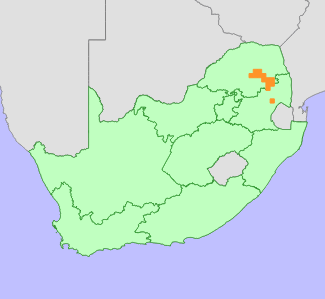|
Scientific Name | Protea rubropilosa Beard |
Higher Classification | Dicotyledons |
Family | PROTEACEAE |
Common Names | Escarpment Sugarbush (e), Platorand-suikerbos (a), Segwapi (ns), Transvaal Mountain Sugarbush (e), Transvaal Sugarbush (e), Transvaalse Berg-suikerbos (a) |
National Status |
Status and Criteria | Least Concern |
Assessment Date | 2019/06/12 |
Assessor(s) | A.G. Rebelo, H. Mtshali & L. von Staden |
Justification | Although Protea rubropilosa has a restricted range, with an extent of occurrence (EOO) of 10 491 km², and is found in grasslands that have been highly transformed in the past, it is still locally abundant. Furthermore, the majority of remaining subpopulations are protected and not declining. It is therefore not in danger of extinction and is listed as Least Concern. |
Distribution |
Endemism | South African endemic |
Provincial distribution | Limpopo, Mpumalanga |
Range | Protea rubropilosa is endemic to the Mpumalanga and Limpopo provinces of South Africa occurring between Lydenburg and Wolkberg. |
Habitat and Ecology |
Major system | Terrestrial |
Major habitats | Long Tom Pass Montane Grassland, Strydpoort Summit Sourveld, Northern Escarpment Afromontane Fynbos, Northern Escarpment Quartzite Sourveld |
Description | It grows on sandstone and quartzite substrates on south-facing slopes, 1400-2300 m. It is a long-lived species, and survives fires by resprouting from aerial stems. Wind-dispersed seeds are stored in fire-resistant inflorescences, and released after fires. It is pollinated by birds. |
Threats |
| Outside nature reserves this species' habitat is extensively modified, and about 43% is already lost due to afforestation. There is ongoing habitat loss, 3% recorded between 1990 and 2014. There is also habitat degradation taking place as a result of escaping pine seedlings from nearby plantations. |
Population |
This species is locally abundant, forming open woodlands with Protea roupelliae. Most of the remaining subpopulations occur within protected areas where they are not declining.
|
Population trend | Stable |
Conservation |
| It is protected within Mount Sheba, Motlatse Canyon, Wolkberg and Bewaarkloof Nature Reserves. |
Assessment History |
Taxon assessed |
Status and Criteria |
Citation/Red List version | | Protea rubropilosa Beard | Least Concern | Raimondo et al. (2009) | | Protea rubropilosa Beard | Not Threatened | Hilton-Taylor (1996) | | Protea rubropilosa Beard | Rare | Hall et al. (1980) | |
Bibliography |
Hall, A.V., De Winter, M., De Winter, B. and Van Oosterhout, S.A.M. 1980. Threatened plants of southern Africa. South African National Scienctific Programmes Report 45. CSIR, Pretoria.
Hilton-Taylor, C. 1996. Red data list of southern African plants. Strelitzia 4. South African National Botanical Institute, Pretoria.
Raimondo, D., von Staden, L., Foden, W., Victor, J.E., Helme, N.A., Turner, R.C., Kamundi, D.A. and Manyama, P.A. 2009. Red List of South African Plants. Strelitzia 25. South African National Biodiversity Institute, Pretoria.
Rebelo, T. 2001. Sasol Proteas: A field guide to the proteas of southern Africa. (2nd ed.). Fernwood Press, Vlaeberg, Cape Town.
|
Citation |
| Rebelo, A.G., Mtshali, H. & von Staden, L. 2019. Protea rubropilosa Beard. National Assessment: Red List of South African Plants version 2024.1. Accessed on 2025/12/23 |
 Comment on this assessment
Comment on this assessment

